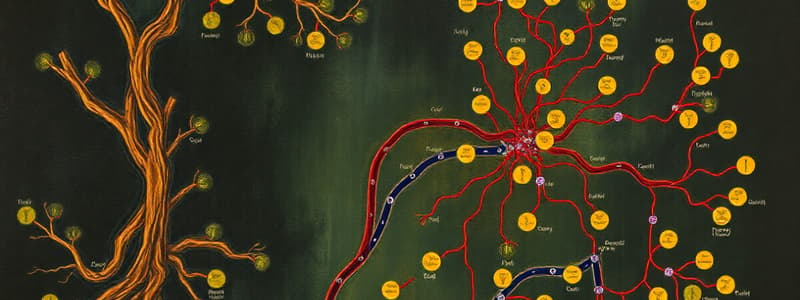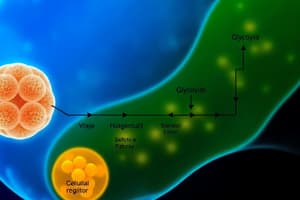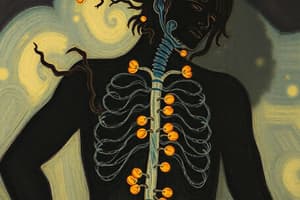Podcast
Questions and Answers
Which statement accurately describes the primary difference between glycolysis and gluconeogenesis?
Which statement accurately describes the primary difference between glycolysis and gluconeogenesis?
- Glycolysis releases glucose into the bloodstream, while gluconeogenesis stores it.
- Glycolysis occurs exclusively in the liver, while gluconeogenesis occurs in all cells.
- Glycolysis breaks down glucose, whereas gluconeogenesis synthesizes glucose. (correct)
- Glycolysis requires ATP, while gluconeogenesis does not require any energy.
What is the role of glucagon in the process of gluconeogenesis?
What is the role of glucagon in the process of gluconeogenesis?
- It stimulates gluconeogenesis to increase blood glucose levels. (correct)
- It enhances glycolysis in muscle cells.
- It inhibits gluconeogenesis to lower blood glucose levels.
- It has no impact on gluconeogenesis.
In which metabolic process is phosphoenolpyruvate primarily involved?
In which metabolic process is phosphoenolpyruvate primarily involved?
- Gluconeogenesis, for synthesizing glucose. (correct)
- Glycolysis, for breaking down glucose.
- Both glycolysis and gluconeogenesis, but mainly in the conversion from glucose.
- Fatty acid synthesis, for energy storage.
What are the end products of anaerobic glycolysis in animals?
What are the end products of anaerobic glycolysis in animals?
During intense exercise, what effect does this activity have on gluconeogenesis?
During intense exercise, what effect does this activity have on gluconeogenesis?
Which phase of glycolysis involves the initial consumption of ATP?
Which phase of glycolysis involves the initial consumption of ATP?
Which of the following sequences correctly represents the conversion of phosphoenolpyruvate to glucose?
Which of the following sequences correctly represents the conversion of phosphoenolpyruvate to glucose?
Which compound is directly produced from glucose during glycolysis?
Which compound is directly produced from glucose during glycolysis?
What role does gluconeogenesis play in the body?
What role does gluconeogenesis play in the body?
Which molecule serves as a precursor for gluconeogenesis?
Which molecule serves as a precursor for gluconeogenesis?
In which cellular location does glycolysis occur?
In which cellular location does glycolysis occur?
Which pathway generates a larger amount of ATP?
Which pathway generates a larger amount of ATP?
What is the net gain of ATP molecules from one molecule of glucose during glycolysis?
What is the net gain of ATP molecules from one molecule of glucose during glycolysis?
Flashcards are hidden until you start studying
Study Notes
Glycolysis
- Metabolic pathway occurring in the cytoplasm of most living cells (bacteria, animals, fungi, plants).
- Primary step in cellular respiration, converting glucose into ATP.
- Inputs: Glucose (six-carbon sugar).
- Outputs: Pyruvate (three-carbon molecule), net 2 ATP, 2 NADH.
- Divided into two phases: energy investment phase and energy payoff phase.
- Types include anaerobic glycolysis (without oxygen) and aerobic glycolysis (with oxygen).
Anaerobic Glycolysis
- End product: Lactate in animals; ethanol in plants and microorganisms.
- Generates ATP without oxygen.
- Less efficient than aerobic glycolysis.
Aerobic Glycolysis
- End product: Pyruvate, which enters mitochondria for further processing in the Krebs cycle.
- Produces a significantly larger amount of ATP than anaerobic glycolysis.
Significance of Glycolysis
- Primary pathway for glucose metabolism in most organisms.
- Provides ATP for various cellular functions.
- Serves as a precursor for other metabolic pathways such as the Krebs cycle and gluconeogenesis.
- Overall reaction:
- Glucose + 2 ATP + 2 NAD+ → 2 pyruvate + 2 ATP + 2 NADH + 2 H+
Gluconeogenesis
- Metabolic pathway synthesizing glucose from non-carbohydrate sources (pyruvate, lactate, glycerol, some amino acids).
- Primarily occurs in the liver and kidneys.
Importance of Gluconeogenesis
- Maintains blood glucose levels, particularly when they drop.
- Provides glucose as a primary energy source for tissues like the brain and red blood cells.
- Essential for liver function and glucose homeostasis.
Key Steps of Gluconeogenesis
- Pyruvate Carboxylation: Conversion of pyruvate to oxaloacetate in mitochondria.
- Oxaloacetate to Phosphoenolpyruvate: Transported to cytoplasm and converted.
- Phosphoenolpyruvate to Fructose-1,6-bisphosphate: Sequential conversion.
- Conversion to Fructose-6-Phosphate: Further transformation in the pathway.
- Glucose Formation: Final conversion of glucose-6-phosphate to glucose.
Differences Between Glycolysis and Gluconeogenesis
- Direction: Glycolysis breaks down glucose; gluconeogenesis builds it up.
- Location: Glycolysis occurs in cytoplasm; gluconeogenesis primarily in liver and kidneys.
- Energy: Glycolysis produces ATP; gluconeogenesis consumes ATP and GTP.
- Irreversible Steps: Some glycolysis steps are irreversible, requiring alternative routes in gluconeogenesis.
Factors Affecting Gluconeogenesis
- Hormonal Influence: Glucagon and cortisol stimulate; insulin inhibits gluconeogenesis.
- Nutritional Status: Fasting or low-carbohydrate diets promote gluconeogenesis.
- Exercise: Intense physical activity can increase gluconeogenesis for muscle energy.
Overall Significance
- Gluconeogenesis is essential for maintaining a steady glucose supply, particularly during fasting or limited carbohydrate intake.
Studying That Suits You
Use AI to generate personalized quizzes and flashcards to suit your learning preferences.




